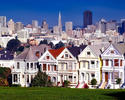Back in 2008 was I one of the first people to start talking about how corporate headquarters were moving back to the global city in the form of the “executive headquarters.” An executive headquarters is one with just the top executives in the firm - from a handful of people up through 500 or so. read more »
Chicago
Exposure Density, Overcrowding and COVID Death Rates: Update
In their new book, Harvard economists Edward Glaeser and David Cutler characterize COVID and related issues as an “existential threat to the urban world, because the human proximity that enables contagion is the defining characteristic of the city” (see our review, Survival of the City: The Need to Reopen the Metropolitan Frontier (Review). read more »
- Login to post comments
Changing Boundaries, Changing Perceptions
What if I told you that Chicago is a midsized, dense urban hub of 800,000 people, surrounded by more than 400 suburbs anchoring a large metro area of 9.5 million? Or that Indianapolis reached its peak population of 476,000 in 1960, and has slipped below 300,000 for the first time since 1930? Or that New York City reached its population peak of 3.4 million in 1950, lost nearly a million people to fall to 2.6 million by 1980, and once again crossed the 3 million person threshold just this past decade? read more »
- Login to post comments
International Traffic Congestion Extinguished by Pandemic and Remote Work
The 2020 TomTom Traffic Index reflects a huge drop in worldwide urban traffic congestion levels. Congestion levels (rated by the percentage of additional time required for auto travel during “rush hour”) dropped in 387 urban areas while increasing in only 13. read more »
The Next Entrepreneurial Revolution
The coronavirus pandemic has altered the future of American business. The virus-driven disruption has proved more profound than anything imagined by Silicon Valley, costing more jobs than in any year since the Great Depression. read more »
Census Bureau Releases 2020 City Population Estimates
The US Census Bureau has just released its July 1, 2020 population estimates for the approximately 19,500 incorporated municipalities (principally called cities, towns, villages). This article provides information on the 50 largest municipalities in the nation (Table below). read more »
The Geography of COVID-19
The ongoing pandemic is reshaping the geography of our planet, helping some areas and hurting others. In the West, the clear winners have been the sprawling suburbs and exurbs, while dense cores have been dealt a powerful blow. The pandemic also has accelerated class differences and inequality, with poor and working class people around the world paying the dearest price. These conclusions are based on data we have repeatedly updated. read more »
Could COVID Exodus Speed the Heartland Revival?
Over the past two decades America’s largest urban areas enjoyed a heady renaissance, driven in large part by the in-migration of immigrants, minorities and young people. But even as a big-city dominated press corps continued to report on gentrification and displacement, those trends began to reverse themselves in recent years as all three of those populations started heading in ever larger numbers to suburbs, sprawling sunbelt boomtowns and smaller cities and out of the biggest ones. read more »
Why More Americans Should Leave Home and Move to Other States
America has been lazily divided by pundits into red and blue states, as if there weren’t constant movement of people between them. Fortunately, reality is a lot more purple — and hopeful — as immigrants, people of color and millennials reshape parts of America by voting with their feet and moving.
These demographic groups are migrating from the big coastal cities to the suburbs, the interior cities, the South and even parts of the Midwest. And in the process, these newcomers change both their new homes and are also changed by them. read more »
- Login to post comments
High-Speed Rail: An Evaluation
Note: This article is adapted from the recently published Reason Foundation report Assessing the Results of the High-Speed Intercity Passenger Rail Program, by Wendell Cox read more »





















